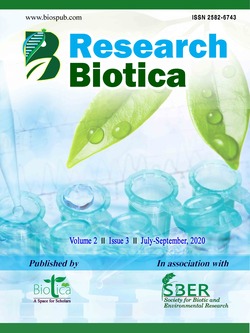
Biochemical Characteristics of Bitter Gourd (Momordica charantia L.) in Southern India
Sathish M.*
Horticultural College and Research Institute, TNAU, Periyakulam, Theni, Tamil Nadu (625 604), India
Lakshmanan V.
Horticultural College and Research Institute, TNAU, Periyakulam, Theni, Tamil Nadu (625 604), India
Juliet Hepziba S.
Horticultural College and Research Institute, TNAU, Periyakulam, Theni, Tamil Nadu (625 604), India
Balakumbahan R.
Horticultural College and Research Institute, TNAU, Periyakulam, Theni, Tamil Nadu (625 604), India
Y.M. Mahadev Prasad
Horticultural College and Research Institute, TNAU, Periyakulam, Theni, Tamil Nadu (625 604), India
DOI: https://doi.org/10.54083/ResBio/2.3.2020.88-90
Keywords: Biochemical characters, Bitter gourd, Momordica charantia L., Parents, Progenies
Abstract
In this present investigation, F4 progenies of three cross combinations of bitter gourd namely, P1 × P4 (MC105 × Pant karela-2), P2 × P4 (TCR471 × Pant karela-2), P3 × P6 (BBGS-09-1 × Arka Harit) and their respective parents P1 (MC105), P2 (TCR471), P3 (BBGS-09-1), P4 (Pant karela-2), and P5 (Arka Harit) were used to analyze the biochemical properties such as total soluble solids, protein content, ascorbic acid content, iron content, momordicine content and total chlorophyll content. The experiment with three cross combination was laid out in a randomized block design. The experiment revealed that the TSS was maximum in progeny P2 × P4 (2.52 ºbrix) while it was minimum in P1 × P4 (2.38 ºbrix). The maximum protein content (1.78%) was recorded in P2 × P4 while it was minimum (1.70%) in P1 × P4. The maximum ascorbic acid content (103.50 mg-100 g-1), iron content (2 mg kg-1), momordicine content (1.98 mg-g-1) and total chlorophyll content (0.43 mg-100 g-1) was recorded in progeny P1 × P4.
Downloads
not found
Reference
Anonymous, 1975. Official methods of analysis. Association of agricultural chemists. Ninetheditior, Washington DC.
Anonymous, 2018. Horticultural Statistics at a Glance (2018). NHB, 2014-15. Ministry of Agriculture & Farmers' Welfare, Government of India. p. 10.
Arunkumar, K.H., Ramanjinappa, V., Patil, M.G., 2011. Genetic variability studies in F2 population of cucumber (Cucumis sativus L.). Plant Archives 11(1), 347-350.
Bahari, M., Rafil, M.Y., Saleh, G.B., Latif, M.A., 2012. Combining ability analysis in complete diallel cross of watermelon (Citrullus lanatus). Science World Journal 2012, 543158.
Bates, M.D., Merrick, L.C., Robinson, R.W., 1995. 24 Minor Cucurbits. In: Evolution of Crop Plants, 2nd Edition. (Eds.) Smartt, J. and Simmonds, N.W. Wiley-Blackwell, New York. pp. 105-111.
Beloin, N., Gbeassor, M., Akpagana, K., Hudson, J., De Soussa, K., Koumaglo, K., Arnason, J.T., 2005. Ethnomedicinal uses of Momordica charantia (Cucurbitaceae) in Togo and relation to its phytochemistry and biological activity. Journal of Ethnopharmacology 96(1-2), 49-55.
Chandravadana, M., Chander, M., 1990. Subcellular distribution of momordicine-II in Momordica charantia leaves. Indian Journal of Experimental Biology 28(2), 185-186.
Choudhury, B.R., Pandey, S., Singh, P.K., Pandey, V., 2014. Genetic diversity analysis for quantitative traits in hermaphrodite ridge gourd (Luffa acutangula (Roxb.) L.). Indian Journal of Horticulture 71(2), 284-28.
Heiser, C.B., 1979. The Gourd Book. University of Oklahoma Press, Norman, UK.
Islam, M.R., Hossain, M.S., Bhuiyan, M.S.R., Husna, A., Syed, M.A, 2009. Genetic variability and path-coefficient analysis of bitter gourd (Momordica charantia L.). International Journal of Sustainable Agriculture 1(3), 53-57.
Kshirsagar, D.B., 2009. Studies on transgressive segregation of F3 and F4 generation in tomato (Lycopersicon esculentum Mill.) with special reference to resistance against leaf curl virus (TLCV). Ph.D. Thesis, M.P.K.V., Rahuri, M.S. India.
Laxuman, L., Patil, S., Salimath, P., Dharmatti, P., Byadgi, A., Nirmalayenagi, N., 2012. Heterosis and combining ability analysis for productivity traits in bitter gourd (Momordica charantia L.). Karnataka Journal of Agricultural Sciences 25(1), 9-13.
Lindasy, W.L., Norvell, W.A., 1988. Development of a DTPA soil test for zinc, iron, manganese and copper. Soil Science Society of America Journal 42, 421-428.
Lowry, O.H., Rosebrough, N.J., Farr, A.L., Randall, R.J., 1951. Protein measurement with the Folin phenol reagent. Journal of Biological Chemistry 193(1), 265-275.
Miniraj, N., Prasanna, K.P., Peter, K.V., 1993. Bitter gourd, Momordica spp. In: Genetic Improvement of Vegetable Crops. (Eds.) Kalloo, G. and Bergh, B.O. Pergamon Press, Oxford. pp. 239-246.
Raja, S., Bagle, B., Dhandar, D., 2007. Genetic variability studies in bitter gourd for zero irrigated condition of semi-arid ecosystem. Indian Journal of Horticulture 64(4), 425-429.
Reddy, B. P., Begum, H., Reddy, M.T., 2013. Variance component analysis of quantitative traits in muskmelon (Cucumis melo L.). Trakia Journal of Sciences 2, 118-124.
Robinson, R.W., Decker-Walters, D.S., 1997. Cucurbits. Volume 6 of Agriculture Series, Issue 6 of Crop production science in horticulture. p. 226.
Salunkhe, D.K., Kadam, S.S., 1998. Handbook of Vegetable Science and Technology: Production, Composition, Storage and Processing, 1st Edition. Marcel Dekker, New York. pp. 273-298.
Salunkhe, D.K., Kadam, S.S., 2005. Handbook of Vegetable Science and Technology: Production, Composition, Storage, and Processing, 2nd Edition. CRC Press, Boca Raton. pp. 282-284.
Singh, A.K., 1990. Cytogenetics and evolution in Cucurbitaceae. In: Biology and utilization of Cucurbitaceae. (Eds.) Bates, D.M., Robinson, R.W. and Jeffrey. C. Cornell Univ. Press, Ithaca. pp. 10-28.
Thangamani, C., Pugalendhi, L., Sumathi, T., Kavitha, T., Rajashree, V., 2011. Estimation of combining ability and heterosis for yield and quality characters in bitter gourd (Momordica charantia L.) Electronic Journal of Plant Breeding 2(1), 62-66.
